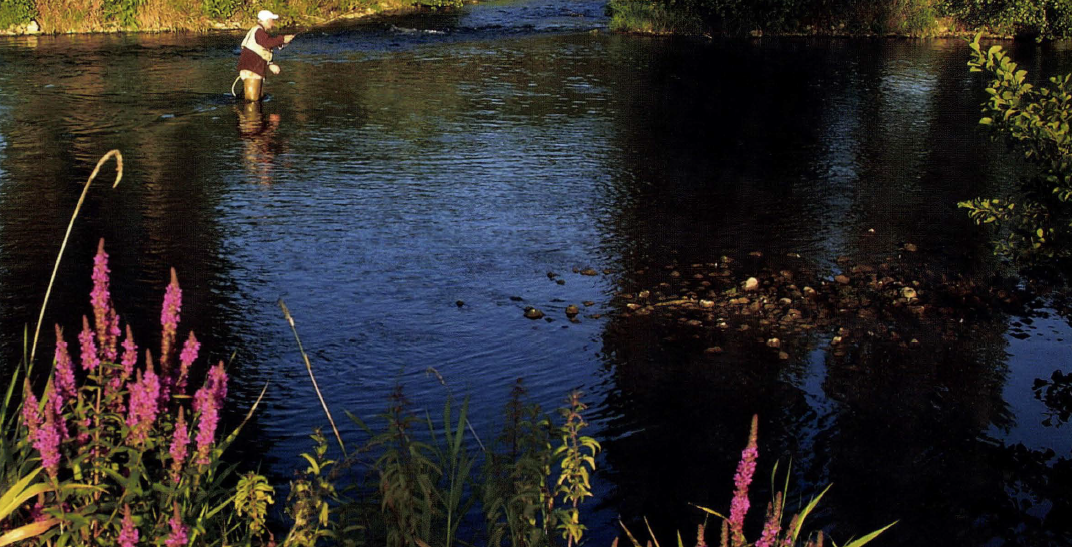Fly Fishing Normandy, France
February 11, 2021



 Fishing,SCA Articles
Fishing,SCA Articles

Walking in the footsteps of Allied soldiers after D-day, you can fish a number of beautiful streams wending through the Normandy countryside.
Of the 153,115 soldiers who landed on D-day’s beaches or on the high ground behind the German lines on June 6, 1944, there’s no record that any carried fly rods. But you can bet that as they swung east from Saint-Lô 18 miles inland and drove toward Paris that summer, among the troops of Patton’s Third Army and Montgomery’s British 21 Army Group were scores of anglers whose heads were turned by Normandy’s great trout rivers – the Touques, the Risle, the Iton, the Eure.
Were it not for the Wehrmacht, fly casters under Montgomery would have felt quite at home. The green, rolling plain was a perfect match for the English countryside of Berkshire, Hampshire and Wiltshire where rise the rivers Test, Itchen, Kennet and Wylye, four of the world’s most renowned chalk streams and the ancestral home of dry fly fishing. Normandy and the South of England are underlain by similar limestone geology, hence the similar habitat.
Of the rivers of Normandy, the Risle is the most famous. Springs in the uplands about 75 miles west of Paris nourish its headwaters, and it matures below Bernay after taking on the Charentonne, itself fine trout water. Not far downstream is the run at Aclou that so charmed hotelier Charles Ritz, whose autobiography, A Fly Fisher’s Life, is a classic. Here the river braids through a wetlands of meadows and forest. Choose between little runs past small islands or fish the main stem, as you like.
Brown trout averaging 13 inches fin beneath grassy undercut banks or among fronds undulating in the current, slightly stained the color of tea. Flows are languid. The current quickens where channels narrow, and it carves pockets that hold bigger fish around tree roots. Riffles, though, are few.
The best fishing begins in mid-May, says Nick Toldi, owner of GourmetFly, a concierge service that offers accommodations and guides on many of the fine rivers in France. That’s when the first hatches of mayflies and big green drakes begin to come off. Hatches are most prolific from afternoon until early evening.
As May warms into June, the hatches erupt later and later in the day. After the green drakes, known as May Flies in France, various species of mayfly and caddis hatch. Nick’s go-to flies become #14 Adams, light or dark Hendrickson, or brown caddis. Nymphing is frowned upon. A 5-weight is all one needs.
During the week of the summer solstice, Nick and his clients will scout their beats during the waning afternoon, fish a bit if trout are rising, settle on the bank for a picnic dinner of game pâté, camembert, crusty bread and a chilled rose or white if the day is hot. They’ll finish with sweet pastries, coffee and maybe a wee dram of Calvados, the apple brandy of the region, or Armagnac. Then the serious fishing begins and continues until after 11 p.m.
In addition to browns, some rivers hold grayling, Thymallus thymallus, a distinctly European species different from Arctic grayling native to Michigan, Montana, Canada and Alaska. A few rivers see runs of Atlantic salmon and sea trout, browns that spawn in freshwater and fatten in salt, but Ireland and the United Kingdom offer much better fishing for them than Normandy.
GourmetFly offers lodging in bed and breakfasts or county homes. If you stay in the latter, each morning you may walk to the patisserie for warm croissants and then over to a café for espresso. Take the time to linger and soak up a bit of morning sun as the village comes to life. After all you didn’t come all the way to fish in Normandy just for the trout.
Ernie Schwiebert fished with Ritz, and they both agreed that one of the finest aspects about the Risle is Paris, about a two-hour drive away. There would be worse fates than to be forced to suffer a week in the City of Light and drive out every day to fish a different river. All of Normandy’s best are within striking range, and Nick can provide guides or directions to beats you can fish by yourself.
Little of Normandy’s fine trout water can be fished without paying a fee. A day permit on the Risle runs 60 Euros and a license is another 10. Rates are similar on the other rivers. A room for two at a country manor bed and breakfast can be found for slightly less than 100 Euros per night.
While in Normandy, plan to devote at least a day touring the beaches where the Allies came ashore only 80 miles to the northwest. If time is really tight and only half a day is available, go first to Pointe du Hoc. Deep craters and shattered concrete gun emplacements testify to the furious bombardment that preceded the assault where U.S. Army Rangers scaled its cliff with ropes and ladders borrowed from London’s fire department. Then visit the U.S. Military Cemetery at St. Laurent where 9,387 soldiers, sailors and airmen are buried. More than half of them lost their lives on D-day and most had yet to turn 25. In all, Normandy offers a great deal of history, gourmet French foods and ideal rivers for fly fishing, and GourmetFly is there to help guide you in your travels and make it the trip of a lifetime.
